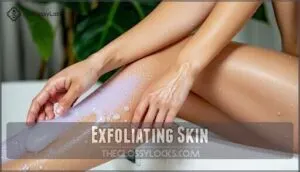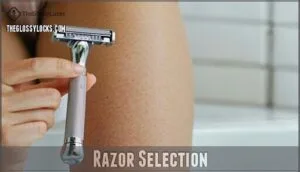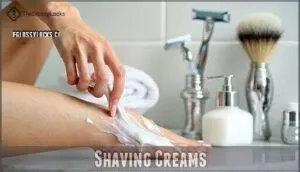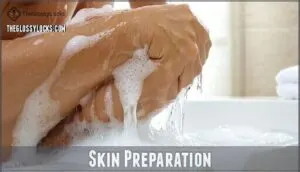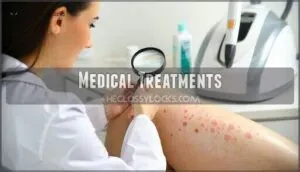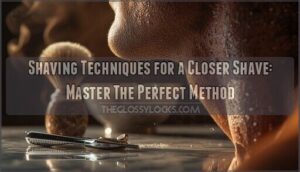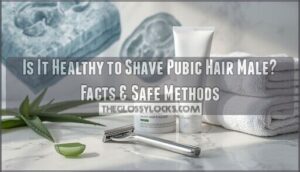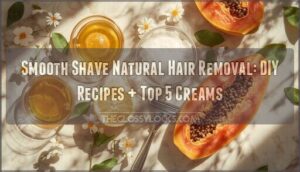This site is supported by our readers. We may earn a commission, at no cost to you, if you purchase through links.

You’ll want to exfoliate regularly before shaving to remove dead skin cells that trap hairs. Always shave with the grain, not against it, using a sharp razor and quality shaving cream.
Don’t press too hard – let the blade do the work. After hair removal, moisturize immediately to keep skin soft and pliable.
Consider switching between shaving and other methods like trimming to give your skin breaks. Women with curly or coarse hair face higher risks, but consistent exfoliation and proper technique can break the cycle of painful bumps and infections.
Table Of Contents
- Key Takeaways
- Causes of Ingrown Hairs
- Prevention Techniques
- Home Remedies
- Shaving Best Practices
- Medical Treatments
- Maintaining Healthy Skin
- Frequently Asked Questions (FAQs)
- How to prevent ingrown hairs down there?
- Why am I so prone to ingrown hairs down there?
- How do you permanently prevent ingrown hairs?
- How to stop getting ingrown hair?
- Can hormonal changes affect ingrown hair frequency?
- Are certain fabrics worse for ingrown hairs?
- Does diet influence ingrown hair development?
- How long do ingrown hairs typically last?
- When should you see a dermatologist?
- Conclusion
Key Takeaways
- Change your shaving technique – Always shave with the grain using a sharp razor and quality shaving cream, and do not press too hard, since this reduces irritation and prevents hairs from curling back into your skin.
- Exfoliate regularly before hair removal – Remove dead skin cells 2-3 times weekly using gentle scrubs or chemical exfoliants to keep hair follicles clear and create a path for hairs to grow outward naturally.
- Moisturize immediately after hair removal – Apply an oil-free, non-comedogenic moisturizer right after shaving or waxing to keep your skin soft and pliable, which prevents hairs from getting trapped beneath the surface.
- Consider laser hair removal for permanent prevention – If you are prone to chronic ingrown hairs, laser treatment destroys follicles at the root and offers the only long-term solution that eliminates the problem instead of just treating symptoms.
Causes of Ingrown Hairs
Understanding what causes ingrown hairs is the first step in preventing those irritating bumps that can turn your smooth skin routine into a frustrating cycle.
Your hair removal methods, natural hair texture, and skin conditions all work together to create the perfect storm for hairs to curl back into your skin instead of growing outward, which can lead to irritating bumps.
Ingrown hairs happen when your hair decides to take a U-turn and grow back into your skin instead of reaching for the sky.
Hair Removal Methods
Every hair removal method you choose affects your risk of developing ingrown hairs.
Shaving cuts hair at skin level, while waxing concerns arise from removing hair at the root. Threading dangers include similar root removal risks.
Depilatory risks involve chemical irritation, though they’re gentler than razors.
Laser hair removal and electrolysis hair removal offer long-term solutions by targeting follicles directly. You can often find these itchy bumps appearing where hair regrows, leading to ingrown hairs.
Curly Hair Types
Because curly hair naturally curves back toward your skin, it creates unique challenges for ingrown hair prevention.
Your curl pattern severity directly affects your genetic predisposition to razor bumps and irritation.
Here’s what makes curly hair tricky:
- Coils grow sideways – Managing coils means they’re more likely to pierce skin
- Specific hair products matter – Wrong formulas worsen the problem
- Tighter curls trap easier – More severe patterns need gentler womens hair removal methods
Skin Conditions
Certain skin conditions create the perfect storm for ingrown hairs. Dead skin cells can clog your follicles, while inflammation makes hair curl back into sensitive skin.
Here’s how different conditions affect your ingrown hair prevention strategy:
| Skin Condition | Impact on Ingrown Hairs |
|---|---|
| Keratosis Pilaris | Excess keratin blocks follicles, trapping hair beneath surface |
| Eczema/Dermatitis | Skin inflammation weakens barrier, increasing bacterial infections risk |
| Folliculitis | Mimics ingrown hairs, causing scarring risks and hyperpigmentation with long-term effects |
Shaving is a common cause, but you can reduce skin irritation by using a sharp razor.
Prevention Techniques
You can prevent most ingrown hairs by making simple changes to your hair removal routine and skin care habits.
These proven techniques work by keeping your hair follicles clear and reducing the chance that newly cut hairs will curl back into your skin.
Shaving Direction
Shaving direction makes all the difference in preventing those pesky bumps.
You’ll want to follow your hair growth patterns rather than fighting against them. Shaving with the grain reduces irritation in sensitive areas like your bikini line and underarms.
A key step is to understand your facial hair growth for best results. Skip multi-directional shaving – it might seem thorough, but it increases your risk of ingrown hairs.
Pay attention to shaving angles and find the ideal direction for each body part. These shaving techniques for women aren’t complicated, but they’re game-changers.
Exfoliating Skin
Beyond proper shaving direction, exfoliating for ingrowns becomes your secret weapon.
Chemical exfoliation with AHAs or BHAs works gently on sensitive skin, while physical scrubs using an exfoliating brush tackle stubborn dead cells.
Your exfoliation frequency should be 2-3 times weekly—overdoing it backfires.
An exfoliating gel offers the perfect middle ground between chemical and physical methods.
Post-exfoliation care matters too; moisturize immediately after skin exfoliation.
This simple step clears hair’s path upward, preventing those pesky bumps before they start.
Many people find success using specialized exfoliating products.
Home Remedies
You don’t need expensive treatments to tackle stubborn ingrown hairs when your kitchen cabinet holds effective solutions.
Simple ingredients like yogurt, oatmeal, and honey can reduce inflammation and gently exfoliate your skin, helping those trapped hairs find their way to the surface.
Warm Compresses
Warm compresses work like a gentle steam treatment for trapped hairs. Apply a washcloth soaked in warm water to affected areas for 10-15 minutes.
This compress temperature opens pores and softens skin plugs covering ingrown hairs. The compress benefits include increased blood flow and reduced inflammation.
Regular exfoliation helps to prevent future clogged follicles. Repeat this compress frequency twice daily for effective bikini area care and prevention.
Natural Treatments
Nature offers powerful solutions beyond warm compresses.
Essential oils like tea tree oil deliver antiinflammatory and antibacterial benefits when applied topically.
DIY scrubs using natural ingredients help release trapped hairs through gentle exfoliation.
Herbal remedies and holistic approaches support your skin care routine, while proper hydration keeps skin supple.
These natural treatments work alongside dietary changes for thorough ingrown hair prevention, utilizing proper hydration to keep skin supple.
Yogurt and Oatmeal Mix
Kitchen staples make surprisingly effective home remedies for ingrown hair prevention.
Mix one-third cup yogurt with two tablespoons oatmeal for powerful inflammation reduction and exfoliation benefits.
The probiotic effects from yogurt promote healing while oatmeal gently buffs away dead skin cells.
This DIY preparation offers skin brightening properties using natural ingredients that cost pennies compared to expensive treatments, providing powerful benefits.
Shaving Best Practices
Your shaving technique makes all the difference between smooth skin and those annoying red bumps that pop up later.
The right razor, proper cream, and good prep work will transform your shaving routine from a gamble into a sure thing.
Razor Selection
Your razor choice makes all the difference in preventing ingrown hairs.
Single-blade safety razors are the best razors women can use for sensitive skin shaving, as fewer blades mean less tugging.
Look for a pivoting head that follows your curves and an ergonomic handle grip for control.
Choosing the right razor can substantially improve your shaving experience.
Electric razors work well too, keeping hair slightly longer to prevent re-entry into skin, which is a key factor in preventing ingrown hairs with sensitive skin.
Shaving Creams
Your shaving cream selection makes all the difference between smooth skin and razor burn nightmares.
Choose cream ingredients like aloe vera or glycerin for sensitive skin protection. Cream alternatives include oils or moisturizing gels that create essential barriers.
Apply using circular motions to lift hairs properly. While cost comparison shows premium products aren’t always better, quality shaving cream prevents ingrown hairs effectively.
Proper brush priming techniques can also improve the shaving experience.
Skin Preparation
Before you even pick up that razor, proper skin preparation sets the stage for a smooth, bump-free shave.
Pre-shave cleansing removes dirt and oils while warm compress application softens hair follicles for easier removal.
- Hydration importance: Shower or bathe first to open pores and soften coarse hair
- Exfoliation types: Use gentle scrubs or chemical exfoliants to remove dead skin cells
- Product selection: Choose oil-free, non-comedogenic cleansers to prevent clogged pores
- Softening hair: Apply warm, damp cloth for 2-3 minutes before shaving
- Skin cleansing: Wash with antibacterial soap containing salicylic acid or benzoyl peroxide
Medical Treatments
When home remedies and shaving adjustments don’t solve your ingrown hair problem, it’s time to visit a dermatologist for professional help.
Your doctor can prescribe stronger treatments like antibiotic creams, steroid medications, or recommend laser hair removal to tackle stubborn bumps and prevent future ones.
Antibiotic Ointments
When infected ingrown hairs develop pus or spreading redness, your healthcare provider might prescribe antibiotic ointment. These topical treatments target skin infection directly at the source. However, resistance concerns make proper application vital—you’ll need to follow instructions precisely to avoid side effects.
When stubborn ingrown hairs won’t budge with home remedies, professional antibiotic treatments become your skin’s powerful backup plan.
One should also be aware that shaving without lubrication may exacerbate such conditions.
| Antibiotic Type | Common Brands | Usage Frequency |
|---|---|---|
| Mupirocin | Bactroban | 2-3 times daily |
| Bacitracin | Neosporin | 1-3 times daily |
| Clindamycin | Cleocin-T | Twice daily |
| Erythromycin | Akne-Mycin | 1-2 times daily |
| Gentamicin | Garamycin | 2-3 times daily |
Alternative antibiotics might be necessary if initial treatments fail. Preventative use isn’t recommended—save these powerful tools for actual infections.
Steroid Creams
When inflammation strikes your skin, steroid creams offer powerful relief for stubborn ingrown hairs.
These antiinflammatory treatments reduce swelling and irritation that won’t budge with home remedies.
Your dermatologist might recommend prescription strength options for severe cases, though over-the-counter versions work well too.
Apply thin layers twice daily, but watch for side effects with long-term use.
Laser Hair Removal
While laser hair removal requires an upfront investment, it’s the only permanent solution that actually eliminates ingrown hairs instead of just treating symptoms.
This advanced hair removal method destroys follicles at their source, giving you lasting freedom from razor bumps.
Key Benefits of Laser Treatment:
- Laser efficacy – Permanently reduces hair growth by targeting follicle roots
- Treatment cost – Higher initial expense but saves money long-term versus repeated treatments
- Pain levels – Mild discomfort during sessions, substantially less than chronic ingrown hair irritation
- Long-term effects – Works on most skin types with lasting results after multiple sessions
Maintaining Healthy Skin
Healthy skin acts like your body’s first line of defense against ingrown hairs, creating the perfect foundation for smooth hair removal and regrowth.
You’ll need a consistent routine that cleanses, exfoliates, and moisturizes to keep your skin barrier strong and your hair follicles clear, which is essential for healthy skin.
Skin Care Routine
Beyond medical solutions, your daily skincare routine becomes your first line of defense against ingrown hairs. A consistent regimen prevents the buildup of dead skin cells that trap emerging hairs beneath the surface.
| Step | Method |
|---|---|
| Cleansing Methods | Use salicylic acid or glycolic acid cleansers twice daily |
| Toning Benefits | Apply alcohol-free toner to balance pH levels |
| Moisturizer Types | Choose oil-free, noncomedogenic formulas for sensitive areas |
| Sunscreen Use | Apply SPF 30+ daily to prevent hyperpigmentation |
| Product Ingredients | Look for BHA, AHA, and niacinamide in skincare products |
Consider using a gentle exfoliating cleanser to further enhance your routine. Your hair removal routines work best when paired with proper skin exfoliation techniques. These skin care tips for women focus on creating an environment where hairs can emerge naturally without getting trapped.
Avoiding Irritation
After establishing your skincare routine, protecting your skin from daily irritation becomes your next priority.
Small changes in your daily habits can prevent razor bumps and razor burn prevention before they start.
Your skin needs gentle care through these shaving tips women swear by:
- Choose Gentle Products with fragrance-free formulas for sensitive areas
- Wear Soft Clothing that won’t rub against freshly shaved skin
- Practice Patch Testing new products before full application
- Remember Hydration Importance by drinking water and using moisturizer
- Minimize Rubbing with patting motions instead of harsh wiping
Reducing Inflammation
When inflammation flares up around ingrown hairs, your skin needs immediate relief.
Hot compresses work like magic, increasing blood flow while soothing angry bumps. Tea tree oil’s antiinflammatory properties tackle inflammation causes naturally, offering steroid alternatives without harsh chemicals.
These natural soothers provide long-term relief when used consistently. Your dietary impact matters too—anti-inflammatory foods support healing from within, and using them can lead to a more natural approach to managing ingrown hairs.
Frequently Asked Questions (FAQs)
How to prevent ingrown hairs down there?
Shave with the hair growth direction using a sharp razor and shaving cream. Exfoliate gently before shaving, moisturize daily, and consider trimming instead of complete removal to reduce irritation.
Why am I so prone to ingrown hairs down there?
Women with curly or coarse hair experience 60% more ingrown hairs.
You’re likely prone because your pubic hair naturally curves, easily getting trapped under skin after shaving, waxing, or tight clothing friction, which makes ingrown hairs a common issue.
How do you permanently prevent ingrown hairs?
You can’t completely eliminate ingrown hairs, but laser hair removal comes closest to permanent prevention.
Consistent exfoliation, proper shaving techniques, and professional treatments substantially reduce occurrence.
Complete prevention requires removing hair follicles entirely.
How to stop getting ingrown hair?
While razor bumps torment your skin, proper technique liberates you from this cycle.
You’ll prevent ingrown hairs by shaving with the grain, using sharp blades, exfoliating regularly, and moisturizing daily to keep follicles clear.
Can hormonal changes affect ingrown hair frequency?
Yes, hormonal fluctuations can increase your ingrown hair frequency.
During menstruation, pregnancy, or menopause, changing hormone levels affect hair growth patterns and skin sensitivity, making you more prone to those pesky bumps, due to hormonal fluctuations and ingrown hair frequency.
Are certain fabrics worse for ingrown hairs?
Tight polyester workout leggings can trap sweat and create friction against freshly shaved skin.
Synthetic fabrics like nylon and spandex worsen ingrown hairs by blocking pores and causing irritation through constant rubbing.
Does diet influence ingrown hair development?
Your diet doesn’t directly cause ingrown hairs, but certain foods can trigger inflammation that worsens existing bumps.
High-sugar and processed foods may increase skin irritation, while anti-inflammatory foods like omega-3s can help reduce redness.
How long do ingrown hairs typically last?
Most ingrown hairs resolve on their own within one to two weeks.
However, if you’re picking at them or they become infected, they can stick around for several weeks or even months longer.
When should you see a dermatologist?
Studies show 60% of people wait too long before seeking professional help.
You should see a dermatologist when ingrown hairs become infected, cause scarring, won’t heal after home treatment, or keep returning despite prevention efforts, which can lead to further scarring.
Conclusion
Breaking free from the cycle of painful bumps doesn’t have to feel like an uphill battle.
These ingrown hair prevention for women strategies work when you’re consistent and patient with your routine.
Remember, your skin needs time to adjust to new techniques, so don’t expect overnight miracles.
Stick with proper exfoliation, gentle shaving methods, and quality aftercare products.
You’ve got the tools now – it’s time to reclaim smooth, comfortable skin that feels as good as it looks.


